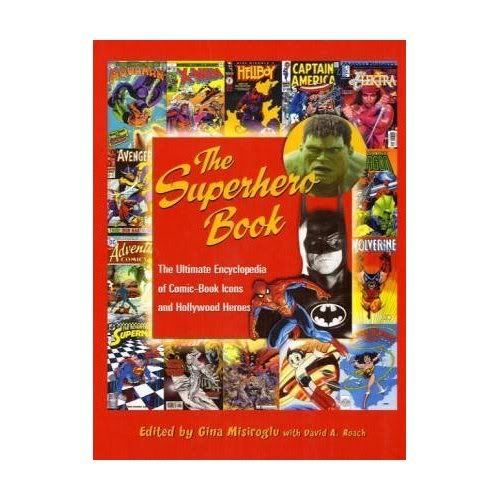
Growing up poor and nomadic in the 1980's, I didn't have many options to entertain myself beyond newsstand comics, magazines, and action figures. We almost never had cable, didn't get a VCR until 1986, and couldn't keep it or the television out of hock more often than not. The library was obviously a great comfort to me, but I regularly heard about things in other media I never got to experience for myself. This developed into a love for books about the movies, music, comics, and so forth I couldn't enjoy for myself. Reviews, synopsis... not unlike what I do at the Idol-Head and here at ...nurgh... Anyhow, I developed an encyclopedic knowledge of several aspects of pop culture, specifically comic books. However, while I often feel like an expert, between all the reading and those years in retailing, I'm delighted when I find something like "The Superhero Book."
It's easy to find titles that give a brief overview of most every example of comic book character under the sun. This book is different, as its many authors don't so much write entries as articles of varying lengths concerning a creation or aspect of the medium. If anything, it reminds me most of the "Steranko History of Comics," really taking a subject by the horns with a candor alien to the authorized/whitewashed biography submitted by the actual publishers. Like "Steranko," there are disputable and plain erroneous "facts" in evidence, but this is the kind of effort that expects the reader to bring a critical mind to play. I'm so enamoured of the book, in fact, I plan to submit bits of information gleaned from it I did not previously know, or at least recall. As I've mentioned, I'm a bit of a know-it-all, so don't expect anything especially obvious here. I'm not saying I don't have my gaps, but if you find yourself going "rrrreally" like I did on the entries to follow, I imagine you'd find even more interesting bits by checking out the book for yourself.
Anyway, as I needed to write that introduction, I'll be starting the alphabetical overview with "B." The letter "A" ran much longer, as "C" promises to, and will each follow in due time...
- I have a better understanding of Badger's whole deal. I never could get into the Nexusverse, so its details and longevity always mystified me.
- The Blackhawks were the only hero team to survive into the Silver Age?
- Black Canary began her career as a "Robin Hood" thief, except she stole from the crooks and gave to herself. An encounter with Johnny Thunder set her straight, and as thanks she only stole two more things-- his slots in Flash Comics and the Justice Society of America. All the hooey about being "inspired" by Batman came later. I also thought Larry Lance was a plainclothes detective, but it seems he was a private investigator whom Dinah Drake frequently rescued.
- Marvel's Blonde Phantom was a big hit in late 1946, where she replaced the heroes that would form the Invaders in "All-Select Comics" in a series of violent and provocative tales. Louise Grant worked for and routinely saved her own P.I. boy friend Mark Mason, a year before Black Canery's debut. Hmm. The Blonde Phantom's success, not to mention the Archie Comics boom, led to the creation of Timely's short-lived line of female super-heroes.
- I knew Blue Beetle was one of the worst long-lived super-hero features of the Golden Age. I did not know he had a radio show, started off as a Green Hornet rip-off, traded in Lev Gleason style sex & violence, and saw his first publisher switch (and switchback) before 1944. I also thought the Steve Ditko revamp lasted longer than a year.
- Note to self: write a blog disputing the time span of the "Bronze Age."
- Bulletman was way more popular than he should have been, with a Bulletboy and Bulletdog in tow, his adventures spanned 150 comics. Bulletgirl was also one of the first super-heroines, and partner in a unisex duo.


No comments:
Post a Comment